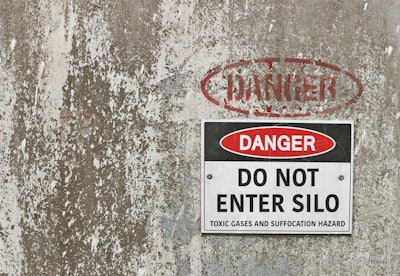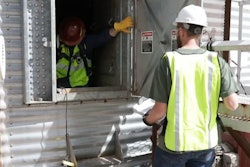
It’s time to stand up for grain safety! Stand Up for Grain Safety Week (standupevents.org/grain), an annual safety outreach effort hosted by NGFA and the Occupational Safety and Health Administration (OSHA), is April 13- 17.
This industry-wide effort to raise awareness about grain handling and storage hazards and to spread resources that provide education and training on best safety practices is made possible through the NGFA-OSHA Alliance, which facilitates cooperation and communication between the regulatory agency and the grain, feed, processing and export industry.
“Enhancing safety in the workplace is everyone’s job,” said NGFA’s immediate past Chairman Eric Wilkey during the 2019 Stand Up For Grain Safety kickoff event.
The NGFA, along with OSHA and its safety week partners – the Grain Elevator and Processing Society (GEAPS) and the Grain Handling Safety Council (GHSC) — are providing resources and safety training guides that everyone working around grain handling facilities can use. If you come across a helpful tip, prevention measure or safety reminder, the NGFA encourages you to widely share it. Small changes can make a big impact when it comes to safety in the workplace.
NGFA is renewing the cooperative alliance with OSHA, which will allow the grain, feed and processing industry to continue to work more closely and collaboratively with the regulatory agency. The new five-year agreement will also include GEAPS and GHSC as signatories. Through the alliance, the NGFA, GEAPS and GHSC will focus on providing their respective members and OSHA staff with information guidance and access to resources regarding the safety and health hazards associated with grain bin entry, machine guarding, respiratory protection, falls, heat, combustible dust, struck-by and lockout/tagout.
The GHSC notes the grain handling industry is a high-hazard industry where workers can be exposed to numerous serious and life-threatening hazards, including fires and explosions from grain dust accumulation, suffocation from engulfment and entrapment in grain bins, falls from heights and crushing injuries, and amputations from grain handling equipment.
During the week of April 13, companies can participate in a nationwide safety effort by hosting a safety stand-up on any prevention measure that addresses grain handling hazards. NGFA will issue daily training guides throughout the week and share updates on social media with #StandUp4GrainSafety.
For those not familiar, a safety stand-up is a voluntary event for employers to talk with their employees about safety best practices. Companies can conduct a stand-up by taking a break to have a toolbox talk or to discuss any safety activity such as conducting safety equipment inspections, developing rescue plans or discussing job-specific identified hazards. It’s important to remember that a small change from any employee that makes the workplace a safer place can save lives.
The NGFA, through funding provided by the National Grain and Feed Foundation (ngfa.org/foundation) has easy-to-share, brief videos on ngfa.org/safety demonstrating safe “Grain Bin Entry” as well as the connection between “Safety and Grain Quality Management” that could be great tools during a stand-up. NGFA also has Safety Tips Sheets dedicated to each of the topics below, which can serve as themes for a facility’s stand-up activity.
Lock out/tag out
The process of shutting down any equipment before entering a grain storage facility is critical to preventing grain bin engulfments. Suffocation, which is a leading cause of death in grain storage bins, can occur when a worker becomes buried (engulfed) by grain as they walk on moving grain or attempt to clear grain built up on the inside of a bin. Moving grain acts like quicksand and can bury a worker in seconds. Bridged grain and vertical piles of stored grain can also collapse unexpectedly if a worker stands on or near it. The behavior and weight of the grain make it extremely difficult for a worker to get out of it without assistance. Employers should not allow workers to enter grain storage facilities without proper equipment, precautions (such as turning off and locking/tagging out all equipment used so that the grain is no being emptied or moving into the bin) and training.
NGFA has Safety Tips Sheets dedicated to “Lock Out/Tag Out” procedures and “Preparing Bins for Entry” at ngfa.org/safety.
Housekeeping and combustible dust
Grain dust explosions are often severe, involving loss of life and substantial property damage. Grain dust is the main source of fuel for explosions in grain handling. It is highly combustible and can burn or explode if enough becomes airborne or accumulates on a surface and finds an ignition source (such as hot bearing, overheated motor, misaligned conveyor belt, welding, cutting and brazing).
Housekeeping is an important part of any safety and health program especially in facilities where combustible material might accumulate. The Occupational Safety and Health Administration’s (OSHA) grain handling standard (1910.272) requires every grain handling facility to develop and implement a written housekeeping program.
Find Safety Tips Sheets on “Housekeeping Requirements” and “Dust Suppression Techniques” on ngfa.org/safety.
Slips, trips and falls
Falls from height can occur from many walking/working surfaces throughout a grain handling facility. Examples of such surfaces include floors, machinery, structures, roofs, skylights, unguarded holes, wall and floor openings, ladders, unguarded catwalks, platforms and manlifts. Falls can also occur as workers move from the vertical exterior ladders on grain bins to the bin roof or through a bin entrance.
The NGFA has an interactive, online training course dedicated to preventing slips, trips and falls – which is free thanks to the National Grain and Feed Foundation. Simply go to ngfa.org/safety and click on Interactive Courses.
These are just a few examples of the what a safety stand-up can cover in your workplace. Managers are encouraged to plan a stand-up that works best for their environment. NGFA has several resources designed to help you participate in Stand Up for Grain Safety Week, including Safety Tips Sheets, training videos, interactive courses, guidance documents and best practice sheets. Browse the website to find training materials that could be helpful in your workplace or contact an NGFA staff member with questions or suggestions for safety guides.
“The true success of this week is if we can save just one life,” OSHA Deputy Assistant Secretary Loren Sweatt noted during last year’s safety week. “Together we can make a difference.”
We encourage every person who works in or around grain facilities to join the effort. ■
Author
Jess McCluer, vice president of safety and regulatory affairs for the National Grain and Feed Association, manages NGFA’s operational programs concerning employee safety and industrial health, environmental issues, grain-handling facility design and equipment, and grain inspection and weighing issues. McCluer joined NGFA in 2007 after serving since April 2003 as a program analyst at the Occupational Safety and Health Administration’s (OSHA) Office of Outreach Services and Alliances.


















